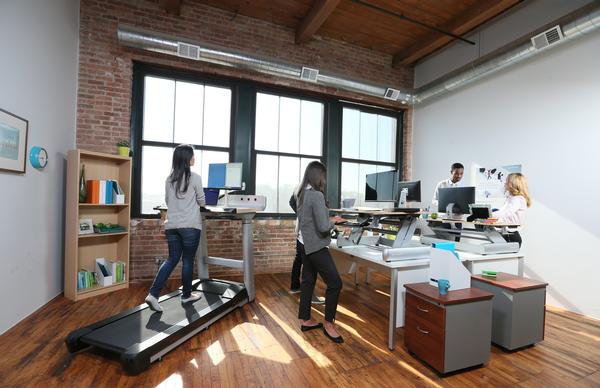



SELECTED
ISSUE
|
|
Leisure Management - Evolution & revolution

Sector trends

|
|
| Evolution & revolution
|

Artificial intelligence, active workplaces and encyclopaedic knowledge about consumer
behaviour. Kath Hudson asks the experts what the future holds for the fitness sector
|
|
|
 |

Neil Harmsworth
COO
payasUgym
 |
|
2016 has been a very exciting year for health and fitness, especially from the perspective of the fitness consumer. The options available to everyone, from the would-be sports enthusiast to the gnarly Ironman veteran, have never been greater.
There are opportunities for businesses that can consolidate these options and make the overall consumer experience smoother and more easily navigable – the need for an ‘Expedia for fitness’ is growing.
There’s also been a vibrant start-up scene in the fitness sector over the last two years, notably in the area of technology. Over the next few years I think we’ll see larger companies drawing inspiration from these smaller, more dynamic businesses. There may even be further acquisitions; we’ve already seen Apple acquiring the health data start-up Gliimpse, and Under Armour acquiring MyFitnessPal.
But for me, the most exciting thing in the market today is not a specific service or audience – it’s the macro trend towards health and fitness as a way of life rather than something you need to do to offset the other elements of your life which may be less healthy.
It’s a trend that’s being driven by Millennials and is here to stay, which is great news for any individual or company operating in the health and fitness sector in 2016 and beyond.
"The most exciting thing in the market today is the macro trend towards health and fitness as a way of life" - Neil Harmsworth, payasUgym
| |


|
| shutterstock |

Millennials are driving the trend towards a health and fitness lifestyle |
|
|
 |

Hugo Braam
CEO and co-founder
Virtuagym
 |
|
The current health club model is broken, at least from a consumer standpoint: so many members give up after the first three months because they lose motivation. There isn’t a good product/market fit and the industry frequently doesn’t deliver on its promise.
I believe technology can improve that fit, and this will represent a win-win for the consumer and the industry.
At the moment, most of the data we collect on the customer journey stays segregated, so you don’t get a full picture of what members are doing – even though gyms can already log visits, cardio equipment used, classes attended, foods consumed, and even the amount of sleep and activity people do outside the gym.
Going forward, data will become more connected – automatically analysed from various sources, and patterns recognised – allowing for more sophisticated member profiling, with tailored programmes to meet the needs and lifestyle of each individual.
In response, the profile of gym staff will change. Instructors will need to develop a broader skill base – not only exercise physiology but also hospitality skills and psychology, to improve motivation and support behaviour change.
If IBM’s super computer Watson is already able to outperform the most experienced radiologist by using a database of millions of radiology pictures and the latest research analysis, it’s easy to see how the technical side of the trainer business could be replaced by technology as well.
Within the next five to 10 years, relatively autonomous technology will be responsible for creating and updating training programmes and offering tailored advice, using a wide array of data points gathered through cardio machines, access control, GPS, and wearables for heart rate, sleep, stress levels and more.
In general, artificial intelligence (AI) is going to change the world in the next decade. Virtuagym is looking at ways to leverage technology and AI to connect all the dots and enable smarter training and a better experience for the health club member, and as such help our industry to the next level.
|
|
 |

Jenny Patrickson
Managing director
Active IQ
 |
|
Going forward, technology will continue to be a big influencer, representing both opportunity and risk. As this area is so fast-moving we can’t be too specific in the content of our qualifications, which usually have a three-year lifespan, but we’re responding by developing qualifications that give individuals a grounding in networked fitness, social media, health and fitness apps and wearable tech, as well as the research skills they will need to keep abreast of technology. We’re also introducing smaller, standalone qualifications, suitable for CPD, which allow us to respond more quickly to technological advances.
There’s a growing need for fitness professionals to have more soft skills too. As more and more technology comes into the marketplace, we believe the role of the fitness instructor will need to evolve: people will provide the empathy with individuals which technology can’t offer.
With events like Color Runs and Tough Mudder growing in popularity, we’re planning to develop qualifications that include modules on engaging with customers who want to prepare and train for special events – for example, modules covering activity-related event planning and organisation.
Other areas in which we’re seeing demand is for sports-specific qualifications, to help people go to the next level, including strength and conditioning, outcome measurement and goal-setting. At the other end of the spectrum, we’re seeing a demand for qualifications supporting physical activity in the early years.
As conditions like mental health, diabetes and obesity become increasingly prevalent, people suffering from these conditions are arguably no longer a ‘special population’. This raises questions about the qualifications needed to work with these target groups. Going forward, specialist qualifications might be encompassed within a refreshed exercise referral qualification, meaning more instructors will be qualified to work with these groups.
| |


|

Active IQ will teach gym staff to support those training for special events |
|
|
 |

Danny Oliver
UK country manager
Life Fitness
 |
|
Reflecting our confidence in the growth potential of the health and fitness industry, Life Fitness plans to double in size between 2015 and 2020, from a US$750m company to a US$1.5bn company. Part of this growth will come about through the broadening of the health and fitness space, which will continue to move beyond the four walls of the health club and into more everyday spaces such as offices, hospitals and old people’s homes. Our recent acquisitions – InMovement, Scifit, Cybex and, subject to regulatory approval in Germany, ICG – have been driven by this trend.
We’ve seen significant changes across the gym floor landscape during the past five years. While the product mix has shifted, the way members consume fitness is also moving. Functional training has grown rapidly, driving small and social group training on the gym floor. Brands like ICG are combining product and technology to deliver highly immersive and innovative fitness experiences, and we will continue to see more of this.
Meanwhile, technology and economic growth have conspired to create a world in which physical movement is more and more an option rather than a necessity. Sitting is the new smoking, and research shows that 30 minutes in the gym doesn’t counteract being sedentary for eight hours a day in the workplace. There’s an opportunity for the health and fitness industry to become part of the solution.
The concept of the active workplace is very current in the US, and will become more commonplace in the UK. Research shows that standing for three hours on workdays burns as many calories as running 10 marathons a year. The personal and corporate benefits of pursuing workplace activity are enormous – preventative healthcare for the individual, and for the employer, reduced absenteeism and improved work performance of employees.
| |


|

The concept of the active workplace is already very current in the US |
|
|
 |

Sean Maguire
Managing director
Legend
 |
|
The health and fitness industry has been slow to adopt technologies already mainstream in other industries such as retail. A good example is data mining. With a few exceptions, most operators have struggled to mine the substantial data sets they own. But help is on the way in the form of easier-to-use data analysis tools, accessible to non-technical users. Once this happens, there’ll be a cultural shift to use evidence, rather than intuition, to make business decisions.
We’ve already started to gather more detailed data about the behaviour of consumers using our software, enabled through the use of self-service and online registration. But wider adoption means we’ll also be more tactical about using this data to differentiate strategy, which will make operations run more smoothly and effectively, in turn improving the customer experience and satisfaction.
We’re entering an interesting new era where everything is joined up, thanks to wearables allowing us to link to what people do outside of the club.
This of course means even richer seams of data to mine. The associated risk is that more data equals a greater chance of drowning in it. This is why innovations to bring analysis to non-technical users is key.
The impact will be felt at the coal face. Data won’t just drive strategic decisions. It will also drive local tactical and operational decisions – for example, optimising capacity usage through the fine-tuning of both pricing and access, and even how waiting lists are operated and fine-tuned.
"More data equals a greater chance of drowning in it; innovations to bring analysis to non-technical users is key " - Sean Maguire, Legend
|
|
 |
| Originally published in Health Club Management 2016 issue 10
|
|
 |
|
